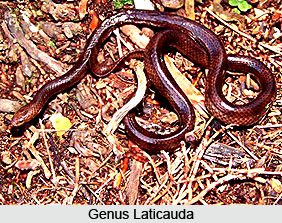 Sea Snakes comprise of about twenty species which are found on the east and west coasts and coastal islands of India. Although often seen in the deep sea, they are more commonly seen caught in offshore fishing nets. Sea snakes have a highly potent neurotoxic venom, but fishermen handle them carelessly, scooping them out of nets and flinging them back into the sea. This is because they very rarely bite; in India there are at most a few deaths every year, always fishermen, never bathers.
Sea Snakes comprise of about twenty species which are found on the east and west coasts and coastal islands of India. Although often seen in the deep sea, they are more commonly seen caught in offshore fishing nets. Sea snakes have a highly potent neurotoxic venom, but fishermen handle them carelessly, scooping them out of nets and flinging them back into the sea. This is because they very rarely bite; in India there are at most a few deaths every year, always fishermen, never bathers.
All sea snakes are characterized by flat, paddle-like tails for efficient swimming. They feed on fish, eels, and fish eggs. Fish are quickly paralyzed by the venom, and swallowed. Sea snakes, excepting the genus Laticauda, bear living young Laticauda lays eggs on land and during the breeding season hundreds of females come ashore on little islands to deposit their eggs. This species, called sea krait, comes on land at other times as well, to bask, shed their skins and perhaps even feed.
From what little observations have been made on sea snakes, they are active both day and night, and can stay under water for up to five hours at a time. They are equipped with glands to remove excess salt from their bodies, and adaptation in common with other marine animals. Sea snakes are not exploited in the regions of India and remain fairly common while in other places the sea snakes are killed for meat. Little is known about its distribution except that Enhydrina schistose is the commonest species.
This article is a stub. You can enrich by adding more information to it. Send your Write Up to content@indianetzone.com











